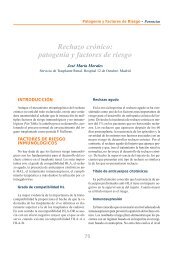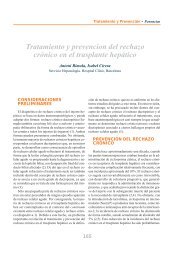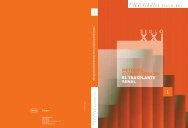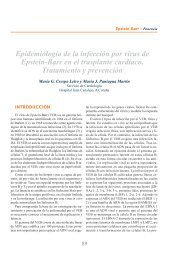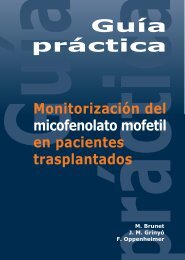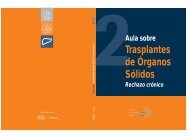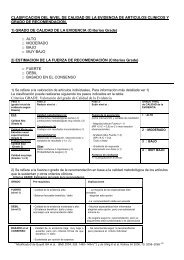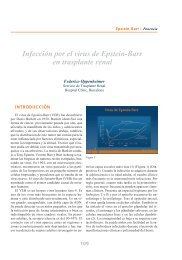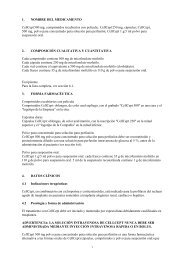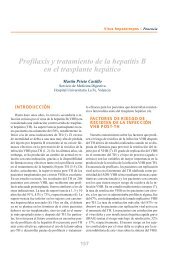Untitled - Roche Trasplantes
Untitled - Roche Trasplantes
Untitled - Roche Trasplantes
Create successful ePaper yourself
Turn your PDF publications into a flip-book with our unique Google optimized e-Paper software.
BIOPSIA DE PROTOCOLO EN EL TRASPLANTE RENAL<br />
A recent analysis of the reproducibility of the reading of arteriolar hyalinosis demonstrates<br />
the problem nicely (14). In this study the authors compared two protocols for reading<br />
–the standard Banff schema and a new schema developed by Mihatsch. The reproducibility<br />
of the new schema was better than the standard Banff schema (kappa statistic 0.67<br />
versus 0.52 comparing 45 biopsies from 38 patients), but the information derived from<br />
the readings was less informative. In the new schema, reproducibility was improved<br />
through reduction of the frequency with which intermediate scoring grades were used.<br />
The number of times when scores of 1 and 2 were used dropped from 64 using Banff to<br />
24 with the new system. This meant that biopsies were scored as 0 or 3 most of the<br />
time, which is little better than a binary decision of present/absent.<br />
The essence of the problem is thus to find the balance between multiple grades of distinction<br />
for a given event such as tubulitis or tubular atrophy, which extracts maximum<br />
amounts of information from the biopsy, and simple grading systems which are highly<br />
reproducible but uninformative. The compromise that is represented by the current Banff<br />
schema, does at least have widespread application across transplant programs and through<br />
many clinical trials. It is important to recognize that it remains limited by the degree of<br />
reproducibility at the margins and could suffer further refinement with benefit. The areas<br />
of contention remain, for example, the relevance of cellular infiltrate in areas of fibrosis.<br />
The current schema requires these to be ignored, but that leads to the potential for variability<br />
in interpretation of exactly what constitutes an area of fibrosis in which the infiltrate<br />
is to be ignored. Fortunately, the schema is under continuous revision and improvement,<br />
so it is reasonable to hold the view that, despite the areas of poor reproducibility, the<br />
Banff schema for the interpretation of renal allograft pathology is the best that we have<br />
available.<br />
DEFINITIONS AND A MODEL OF CAN<br />
Understanding the complexity of the entity of chronic allograft nephropathy (CAN) has<br />
taken many years, since unlike acute rejection, it cannot be easily identified clinically, is<br />
multifactorial in origin and evolves over years and not days or hours. The reliability and<br />
sensitivity of serum creatinine measurement contributed substantially to the ability to<br />
diagnose and treat acute rejection in the early years of transplantation and is still one of<br />
the most reliable tools that we use in the clinic to identify patients in need of further investigation<br />
and change in management during the first few weeks after a renal transplant.<br />
Since the serum creatinine is also a fairly reliable indicator of chronic graft failure,<br />
as demonstrated by studies examining creatinine at one year as a predictor of graft loss,<br />
it has been natural to assume that monitoring the serum creatinine will identify grafts at<br />
risk from chronic graft failure and CAN. Experience has, however, taught us that this strategy<br />
does not, on the whole, allow identification of CAN at a stage when intervention can<br />
substantially alter the course of events. It is central to the understanding of CAN to realise<br />
why this is the case. It is also central to any strategies that might be effective in the<br />
16




